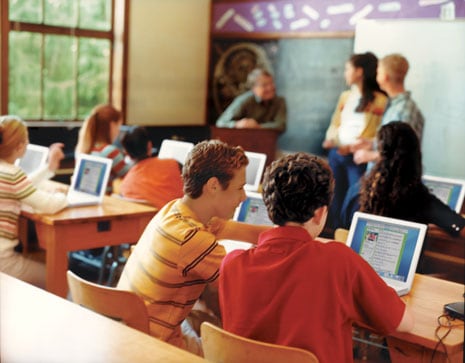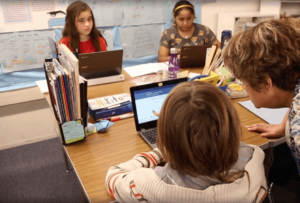How to Leverage Tech to Keep Students Focused
By Alexia McCormick

Technology has the potential to dramatically change the role of teachers, especially when it comes to secondary and higher education. Students no longer need instructors to pass along facts when they have access to the internet and other data gathering sources that they can use to learn the essentials. Teachers, then, must transition to take on more of a “guiding” role in students’ education—they should suggest materials and assign exercises to help students think deeply about and synthesize information.
As facilitated by technology, this transition from lecturing to directing learning can be an incredibly positive thing for both teachers and students. Students are able to take on more responsibility for what they learn, and teachers have the satisfaction of helping their students get deeper into key concepts.
Unfortunately, the reality of technology in the classroom sometimes falls short of this ideal. Students can be easily distracted when using laptops, for instance, or they may not take full advantage of what the tech has to offer, instead choosing to use their time to engage in social media or read non-relevant blogs. Teachers in this situation are often relegated to the role of cheerleader as they try to compete with students’ attention.
Tech Management Software—Bridging the Gap for Effective Use of Technology
The challenge, then, is to allow students the flexibility to use computers and similar devices in the classroom while providing enough management power to the instructor to help keep the class focused. It was this problem that led the developers at Netop to create classroom management software to allow teachers to remain in control of their teaching environments. We saw the need for in-classroom tech management software as essential, especially as some schools began banning the use of computers or other student-operated tech outright. We believe that there should be middle ground between letting students have free range to research what they want and keeping them on task.
Some key features that we included to achieve this balance are the following:
- Screen sharing – Instructors can display their screens on their students’ devices to give them an up close look at an equation or a website.
- Student supervision – Teachers have the option of viewing expandable thumbnails of each student’s screen to make sure everyone is on task.
- File sharing – It’s simple to transfer files and distribute assignments instantaneously to the entire class.
- Interaction – Instructors can take student surveys to check for understanding or showcase student work on other screens to encourage discussion of ideas.
- Student lock-out – There’s an option to freeze students’ screens or shut down their machines remotely. This is useful for specific classroom tasks where the teacher needs students to engage in offline discussion or announcements.
- Simultaneous application launch – Teachers can launch applications or load websites simultaneously on all classroom computers.
These features are designed to allow instructors to use technology effectively and efficiently while still allowing students to learn at their own pace.
How does technology inform your classroom instruction? What methods have you found to be effective in the classroom for keeping students focused while still engaging with technology?
Alexia McCormick is a writer for Netop. When Alexia is not writing, she enjoys sewing & learning about advancements in education. Netop has been a leader in classroom management software, live chat software solutions and secure remote access for business and educational institutions for almost three decades.




walden student 1
Thank you for providing this information in todays fast technology age. I teach students with disabilities who does not have reading skills and computers without accessability features are not the best learning tools for significantly low students. When I started working with students using the first ipad we had many challenges such as studnets going off the learning task and being destracted. If I used computers I would have many options to controll what the studnets are looking at from one desk. I guess my underlining point it students with disabilities need to be focused on to in this technology changing world and how can best help them. Also, students in general education have a tool for learning that is great and teachers have a way to monitor thier activity.
Miguel Salinas
It is no surprise that youth are becoming more savvy with technology and we agree that it can be leveraged as a powerful learning tool. With the Adobe Youth Voices program, we’ve found that empowering youth with digital tools allows them to further express their creativity while also learning how to use industry-standard software and other technology. Adobe Youth Voices and our Essentials curriculum, provides a great combination of technology and learning to prepare youth for the 21st century jobs.